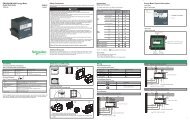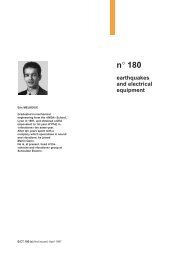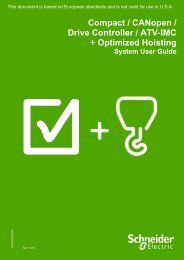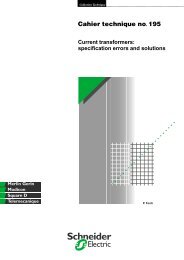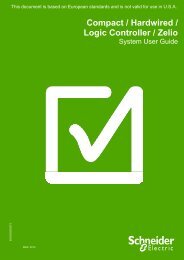Low Voltage circuit-breaker breaking techniques - Schneider Electric
Low Voltage circuit-breaker breaking techniques - Schneider Electric
Low Voltage circuit-breaker breaking techniques - Schneider Electric
- No tags were found...
You also want an ePaper? Increase the reach of your titles
YUMPU automatically turns print PDFs into web optimized ePapers that Google loves.
If they are to suit all standard cases, <strong>circuit</strong><strong>breaker</strong>smust therefore be able to establishcurrents 15 to 20 times greater than their ratedcurrent.Specific measures must be taken to perform thisfunction, since a <strong>circuit</strong>-<strong>breaker</strong> must always beready to open again in the event of aninstallation fault, even during or just after it hasclosed !Current conductingThis passive function requires a number ofconstruction precautions if both an acceptabletemperature rise and the possibility of quickopening are to be obtained.Furthermore, if the <strong>circuit</strong>-<strong>breaker</strong> is of thediscriminated type, it may require a highelectrodynamic withstand to accept short-<strong>circuit</strong>currents during the discrimination time,necessary for the downstream devices tooperate.Circuit opening, current <strong>breaking</strong>c by voluntary action on the mechanism, manualor remote controlled; any current can be broken.c by reflex action on the mechanism by the tripunit due to an overcurrent. The <strong>circuit</strong>-<strong>breaker</strong>automatically and permanently opens, even if theoperating device is held in the "closed" position.c by action of an auxiliary trip unit on themechanism:Undervoltage, energising, earth leakage currentdevices... Opening is automatic and permanent:the current can have any value at this time.IsolationWhen the <strong>circuit</strong>-<strong>breaker</strong> is open, a certainisolation level is required between the"energized" and "de-energized" parts.The level is checked by insulation tests such asthose prescribed by IEC 60947-2 standards:c a maximum leakage current test between inputand output under max Ue;c an impulse voltage (e.g. 12.3 kV instead of the9.8 kV required for a device of the same typewithout this function);c a mechanism sturdiness test, known as the"welded contact" (see the <strong>Schneider</strong> <strong>Electric</strong>"Cahier Technique" no. 150).6.2 Its technologiesThe mechanismsThe three basic principles are:c mechanism «with 2 stable positions»(for <strong>circuit</strong>-<strong>breaker</strong>s with ratings under 100 A);c mechanism with «3 stable positions»particularly used in industrial <strong>circuit</strong>-<strong>breaker</strong>s(see fig. 22). Their operating device enables:v sudden closing of contacts, regardless of howthey are operated,v sudden opening of contacts, regardless of howthey are operated,v opening by tripping, suddenly and even if thehandle is held. Resetting must then precedereclosing,v positive break (the operating device can onlybe padlocked in the "O" position if the contactsare really open);c mechanism for high current, moresophisticated <strong>circuit</strong>-<strong>breaker</strong>. This type has adevice for charging energy storage beforeclosing and opening, thus allowing an "O - FO"cycle without intermediate resetting.The trip unitsIn view of trip unit diversity, only the basicprinciples providing the minimum knowledgerequired to study overcurrent <strong>breaking</strong>, arereviewed below:c The thermal-magnetic trip units:v in overload conditions, significant overheatingof a particular current (or temperature in manycases) causes tripping by a "thermalmechanical"element, generally a bimetal strip.- Trip unit nominal rating is defined bytemperature rise conditions in asymptoticheating.The trip unit can be "compensated" to prevent itbeing affected by ambient temperature.- in high overload conditions, temperature risesdevelop in adiabatic heating. Tripping time thusdepends on the <strong>circuit</strong>-<strong>breaker</strong>'s preliminarytemperature rise.v in short-<strong>circuit</strong> conditions, as from a certaincurrent threshold, tripping is performed"instantaneously" by a magnetic <strong>circuit</strong> whichactuates an armature or a core.This threshold is defined on a current impulse of200 ms. However its action time is extremelyreduced (3 to 5 ms) for high currents;c "electronic" trip unitsTheir prime purpose is evaluation of the currentflowing through the <strong>circuit</strong>-<strong>breaker</strong> poles to takethe appropriate action on a tripping device.Their advantages are:v greater precision of target thresholds,v tripping curves which can be adjustedaccording to use,v local or remote information possibilities.Cahier Technique <strong>Schneider</strong> <strong>Electric</strong> no. 154 / p.20






